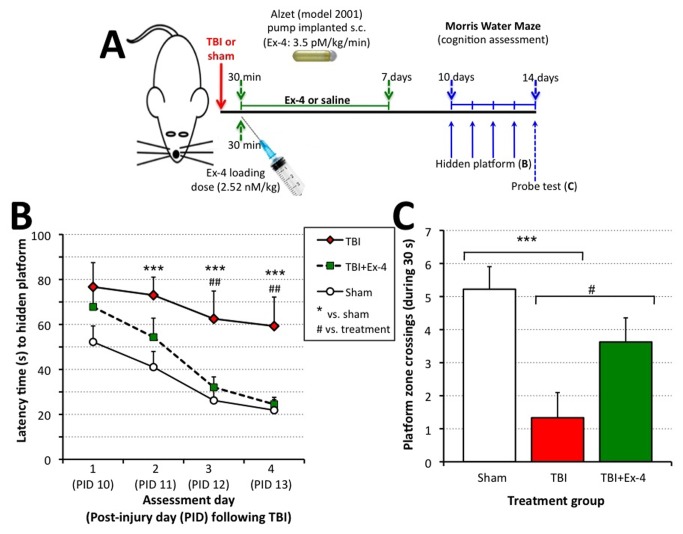Figure 2. Studies of Exendin-4 in vivo.
Administration of Exendin-4 (Ex-4) significantly ameliorated cognitive impairments induced by fluid percussion-induced TBI in rats assessed by the Morris Water Maze (MWM) paradigm. (A) Time line of study: 30 min following fluid percussion injury-induced TBI or sham treatment, rats were administered either saline or Ex-4 for 7 days (initially, a loading dose of Ex-4 was administered followed by steady-state subcutaneous (s.c.) infusion via an implanted Alzet mini pump). Thereafter on days 10 to 14, animals were subjected to MWM assessment. (B). Post-injury administration of Ex-4 significantly improved MWM performance. Cognitive performance as assessed by latency to locate the hidden platform in the MWM was compared for each of the three treatment groups, TBI (n = 9), TBI+Ex-4 (n = 8), sham (n = 9). A repeated-measures ANOVA showed significant between group differences. Post hoc analysis using Fishers LSD revealed that animals that were treated with Ex-4 after TBI had significantly shorter latencies to reach the goal platform as compared to injured saline-treated. No significant difference was observed in the performance between TBI+Ex-4 and sham groups. Data are presented as the mean ± SEM. ***p≤ .001, sham relative to TBI. †† p≤ .01, Ex-4 relative to TBI. (C) Number of platform zone crossings during the probe trial. Cumulative learning for the platform location was assessed during the probe trial as the number of times the animals swam within a 7.5 cm radius of the platform border (i.e., 2x the diameter of the platform). One-way ANOVA indicated significant between group differences. Fisher’s LSD post hoc showed that sham and TBI+Ex-4 had better retention of the platform location relative to animals that received TBI only. Data are presented as the mean ± SEM. Brackets indicate direct comparisons between groups. *p≤ .05, ***p ≤ .001.

